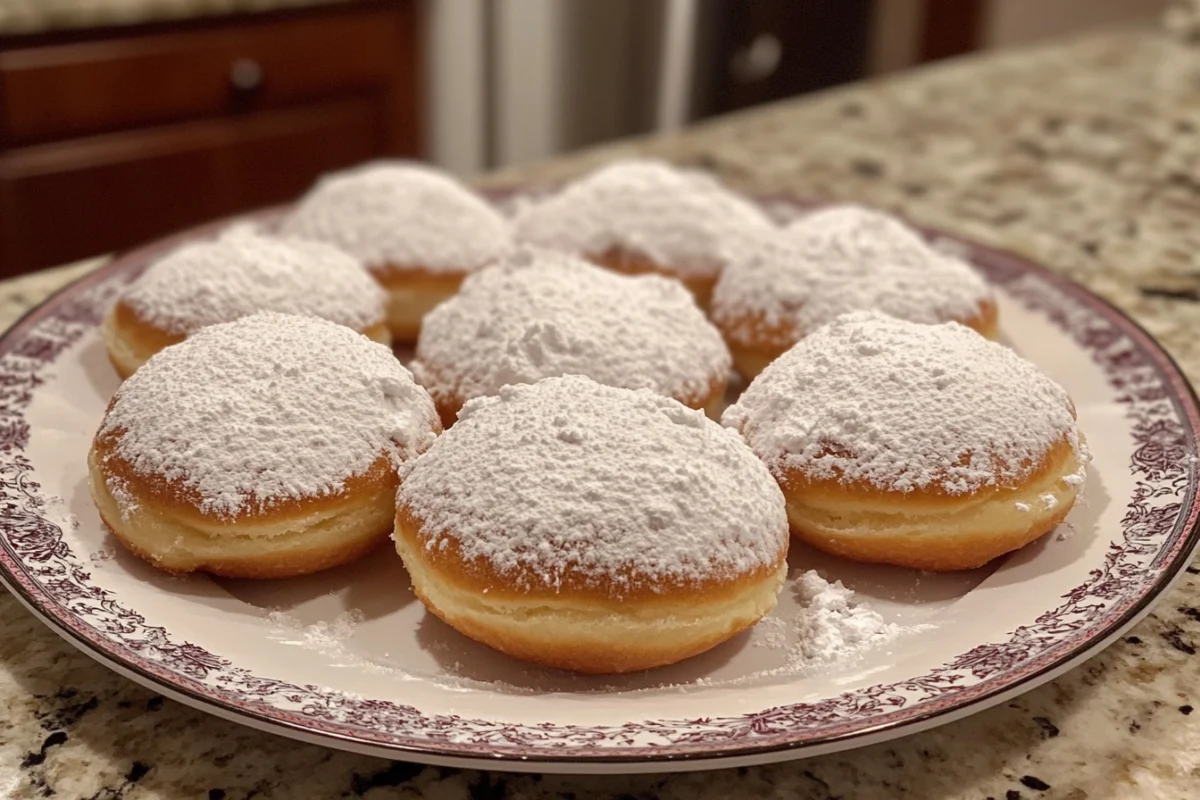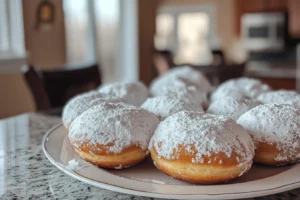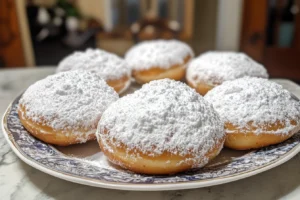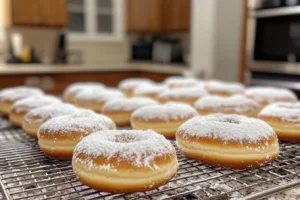This article explores the natural components of powdered donuts, from dough to dusting. Learn about the ingredients and how they create this classic treat.
Understanding Naturally the Donut Dough Ingredients
What makes a powdered donut so delightful? It starts with the dough. Naturally, this dough often contains simple ingredients. Flour, for instance, forms the base. Furthermore, sugar adds sweetness. Yeast helps the dough rise, creating a fluffy texture. Water or milk provides moisture, and sometimes eggs are included for richness. Salt is added to enhance the flavor, therefore, the ingredients are very straightforward.
The Role of Flour in Donuts
Flour is a natural and vital component of donut dough. Specifically, it provides the structure. The gluten in flour gives the donut its elasticity and chewiness. Different types of flour can be used. Consequently, each affects the final product’s texture. All-purpose flour is most common. However, other flours can alter the donut’s qualities. For example, bread flour might give a chewier result.
Sugar’s Impact on Sweetness
Sugar is crucial for the sweet taste of powdered donuts. Moreover, it also affects the texture and color. Sugar helps in browning during frying. Therefore, it’s an important part of the recipe. Different types of sugars also can be used, each influencing the result.
The Importance of Yeast for Dough Rise
Yeast is another vital natural ingredient in many donuts. It’s a living organism that eats the sugars in the dough. Naturally, the yeast produces carbon dioxide gas. This makes the dough rise and become light. There are various types of yeast. Therefore, the recipe might specify which type to use.
The Impact of Water, Milk, and Eggs
Water or milk provides hydration to the dough, and eggs add richness. Additionally, these liquids combine the dry ingredients. The balance of liquids is crucial. Therefore, it affects the dough’s consistency and texture. Eggs also add fat and help the dough stay moist after cooking.
Salt’s Enhancement of Flavor
Salt is used to enhance the flavor of powdered donuts. While it might seem surprising, salt balances the sweetness. It also plays a role in gluten development. Consequently, the right amount of salt is important for the final taste.
Frying: How Dough Transforms into a Donut
Frying is the next important step after mixing the dough. Naturally, the hot oil cooks the dough quickly. The oil’s temperature is very important. It needs to be hot enough to cook the donut evenly. However, too hot, and the outside will burn before the inside is cooked. Therefore, it’s a critical aspect of donut creation.
The Impact of Oil Temperature
The oil’s temperature is crucial for the donut’s texture. Too low, and the donut may absorb excessive oil. Therefore, it will become greasy. Too high, and the outside will brown too quickly. Ideally, the oil should be around 375°F (190°C). Furthermore, it must be carefully monitored to ensure perfect frying.
The Frying Process Step-by-Step
During frying, the dough expands rapidly. Consequently, the sugars caramelize, creating a golden-brown color. Once fried, the donuts are usually drained on a rack. This allows excess oil to drip off. Thus, the donuts will be ready for dusting.
The Natural Sweetness of Powdered Sugar
The final step in making a powdered donut is the dusting with natural powdered sugar. This fine, sweet powder is what gives these donuts their unique look. The sugar is also what provides the final touch of sweetness. Furthermore, it creates that satisfyingly sweet coating.
What Is Powdered Sugar?
Powdered sugar, also known as confectioners’ sugar, is finely ground granulated sugar. It has been pulverized until it’s a soft, fine powder. Sometimes a little cornstarch is added. Therefore, it prevents clumping. Naturally, the pure sugar is all that is needed.
How Powdered Sugar Sticks to Donuts
The slight moisture on the fried donut helps the sugar stick. It’s applied while the donut is still warm. Therefore, the sugar adheres better to the donut’s surface. A generous coating is used. This creates that characteristic white dusting.
Exploring Naturally the Simple Sweetness
The simple natural sweetness of powdered sugar complements the donut flavor. It offers a light, melt-in-your-mouth taste. The pairing of the dough and the sugar is what makes this treat so satisfying. Furthermore, it is the natural combination that makes it so popular.
Naturally Understanding Different Donut Variations
While the traditional powdered donut is loved, there are many variations. Each type offers a slightly different experience. Some variations might use different flours, flavorings, or coatings. Consequently, it will create something new.
Cake Donuts vs. Yeast Donuts
Cake donuts are denser and more cake-like. They usually contain a chemical leavening agent, like baking powder. Yeast donuts, however, are lighter and airier. Therefore, they rise with yeast. These differences affect the final texture of the donut.
Variations in Flavorings and Additions
Flavorings like vanilla or cinnamon can be added to the dough. Moreover, nuts, chocolate chips, or spices are also used. These changes can elevate the natural base. Furthermore, it will create a completely unique flavor profile.
Alternative Natural Coatings
Although powdered sugar is common, other toppings are also possible. Glazes, for example, can provide a sticky, sweet coating. Alternatively, sprinkles, chocolate, or other toppings are sometimes used. These add another level of fun and taste.
The Naturally Occurring Science Behind Donuts
There is a science to baking, and donuts are no exception. The ingredients work together in specific ways. Heat is also crucial, changing the ingredients’ chemical makeup. Understanding these processes can make you a better baker. Therefore, the right technique is key.
The Chemistry of Baking Dough
The gluten in flour, the yeast, and the liquids are crucial elements. These components go through chemical reactions. These reactions create the structure and texture of the dough. Specifically, the yeast eats sugars and releases gases. Therefore, the dough expands.
The Role of Heat in Donut Formation
Heat causes changes in the dough, too. It coagulates the proteins and sets the structure. Additionally, it caramelizes the sugars. Consequently, this creates color and flavor. Understanding these processes helps with more consistent results.
Understanding the Naturally Occurring Interactions
All the ingredients interact in particular ways. Therefore, it will achieve the desired texture. Sugar balances moisture, fat adds richness, and salt enhances the taste. Therefore, the balance is essential. Naturally, the results are very yummy.
Health Considerations for Naturally Eating Donuts
While donuts are a tasty treat, consider them an occasional indulgence. Therefore, it’s important to know their nutritional content. Naturally, they are high in carbohydrates and fats. Be aware of the amounts and how it fits your personal health.
Calories and Sugar Content
Powdered donuts contain a high number of calories. Much of this comes from sugar and fried dough. Keeping track of consumption is important. This helps in making healthier decisions.
Fats and Carbohydrates
Donuts are also high in fats. Additionally, they are high in carbohydrates. Therefore, they are not a good choice for everyday snacking. Consuming too many can lead to health problems. Moderation is key to keeping a healthy diet.
Making Healthier Choices
It’s possible to make healthier versions of donuts at home. For instance, baking instead of frying reduces fat content. Using whole wheat flour can add fiber. Controlling the sugar amount can also help. Therefore, there are ways to make things better.
Tips for Making the Best Powdered Donuts
Making excellent powdered donuts at home is achievable. Some important steps can improve your results. Attention to detail is paramount, especially with the dough and frying. Therefore, follow the tips to achieve success.
Dough Preparation Best Practices
Mixing the ingredients properly is vital. Don’t overmix the dough. This can result in a tough texture. Allow enough time for the yeast to activate. Consequently, this will help the dough rise correctly.
Frying Techniques for Success
Keep a close eye on the frying oil’s temperature. Use a thermometer to ensure accuracy. Don’t overcrowd the fryer with too many donuts. This can lower the oil temperature. Therefore, it can affect the end result.
Proper Dusting Techniques
Dust the donuts while they are still warm, but not too hot. Ensure an even coating of sugar. This provides the characteristic white dusting. Use a fine-mesh sieve for even coverage. Therefore, the process should be neat.
Enjoying Your Naturally Homemade Powdered Donuts
After all the work, it’s time to enjoy your homemade powdered donuts. Whether served warm or at room temperature, they are a tasty treat. Sharing them with family and friends makes the experience even better. Naturally, a treat like this deserves enjoyment.
Serving Suggestions
Pair your donuts with coffee or milk for a simple meal. Alternatively, you can serve them with a scoop of ice cream. Experiment with different pairings. Therefore, find the combinations that work best for you.
Storing Leftover Donuts
Store leftover donuts in an airtight container. They can be kept at room temperature for a few days. Consequently, they will stay fresh for longer. They are best consumed within a day or two.
Appreciating the Process
Creating treats at home is a wonderful experience. The effort put into making something delicious is rewarding. Naturally, the homemade result is better. Therefore, enjoy the whole process.
The Naturally Timeless Appeal of Powdered Donuts
Powdered donuts have been a beloved treat for many years. Their simple yet satisfying flavor is timeless. Consequently, they are enjoyed by many people. Naturally, they bring joy with every bite.
Cultural Significance
Donuts are a popular treat in many countries. They are often eaten at breakfast, but can be enjoyed anytime. They are present at gatherings, parties, and everyday meals. Therefore, they are part of many cultures.
Why They Are So Popular
The light, sweet flavor of powdered donuts is simple. However, it is quite satisfying. The pillowy dough combined with the sweet sugar is simply great. Furthermore, the texture and taste is a treat for many.
The Future of This Treat
While recipes change, the love for powdered donuts won’t fade. People will continue to eat this classic. Naturally, they will always be a part of the culinary landscape. Therefore, their future is secure.
Frequently Asked Questions (FAQs)
What exactly is powdered sugar made of?
Powdered sugar is finely ground granulated sugar, sometimes with a small amount of cornstarch added to prevent clumping.
What type of oil is best for frying donuts?
Vegetable oil, canola oil, or peanut oil are all good choices for frying donuts because they have high smoke points.
Can you make powdered donuts healthier?
Yes, you can make healthier donuts by baking instead of frying, using whole wheat flour, and reducing the amount of sugar.
How should I store leftover powdered donuts?
Store leftover powdered donuts in an airtight container at room temperature for up to two days to maintain their freshness.
Conclusion
In conclusion, understanding what powdered donuts are naturally made of helps appreciate them. From flour and sugar to yeast and oil, each component plays a crucial role. Moreover, mastering the process of mixing, frying, and dusting leads to great results. Naturally, this is a treat worth enjoying. This knowledge enhances the experience of making and eating these sweet treats, making it a more natural and satisfying endeavor. The simple ingredients, when combined correctly, create something special, and understanding these elements allows for better and more informed preparation.
Looking for more donut inspiration? Be sure to check out our homemade donut recipes for more ideas to satisfy your sweet tooth.




